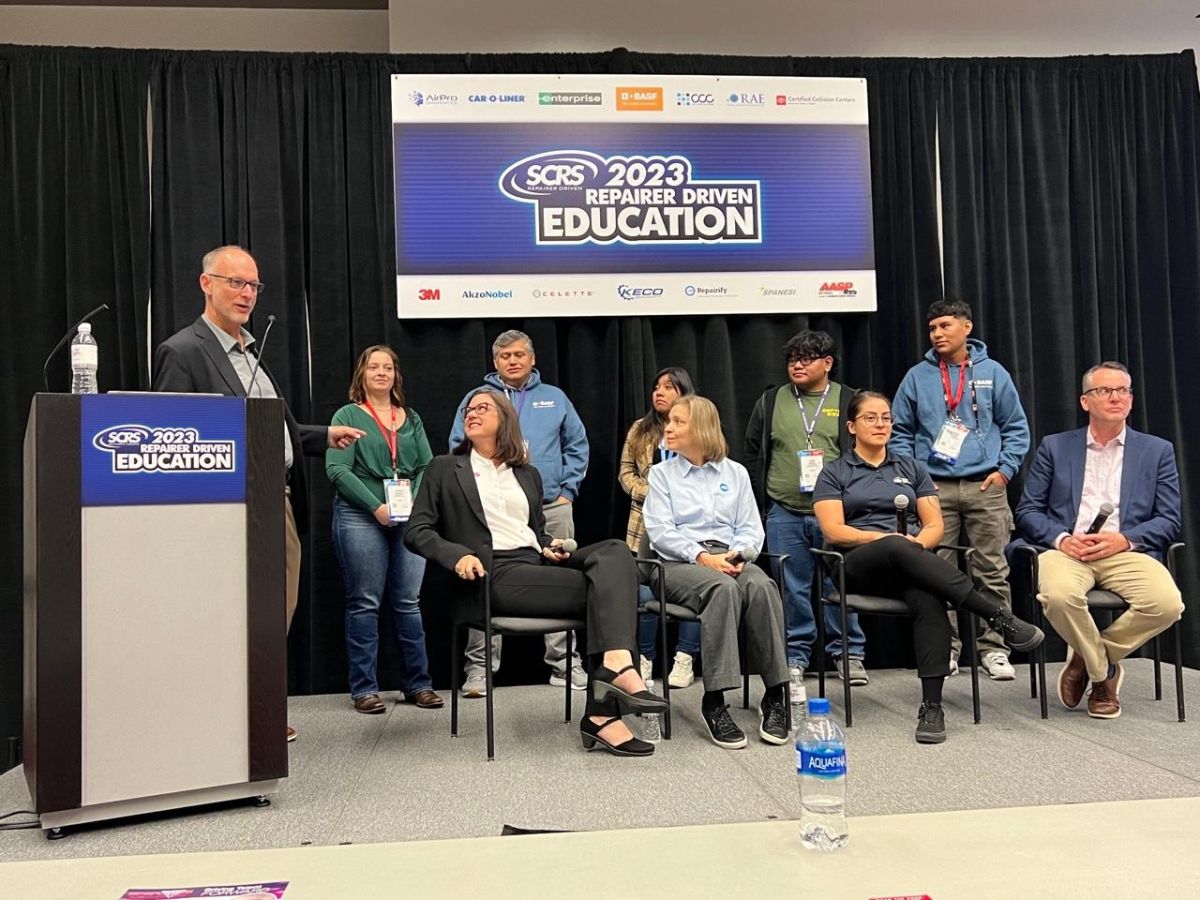A panel of experts---along with several current students---came together during the 2023 SEMA Show to talk about what the collision repair industry needs to do to attract and retain the new technicians it will need over the next several years.
The panel was part of the Society of Collision Repair Specialists’ Repairer Driven Education series. Jeff Wildman, manager of the talent attraction program for BASF, moderated the discussion, while the panelists included Jennifer Maher, CEO of the TechForce Foundation; Donna Wagner, vice president of industry and media relations for ASE; Laura Lazano, professor of collision repair and automotive department co-chair at Contra Costa College in San Pablo, CA; and Brandon Eckenrode, executive director of the Collision Repair Education Foundation (CREF).
“We need almost 1 million techs in the automotive industry by 2026, and 113,000 in collision repair,” Wildman said.
The students shared a bit about their reasons for pursuing a career in collision repair, and what they hope to accomplish.
Victoria Callowhill, of Frisco, TX, is a student at Collin College, aiming for a career in restoration and collision repair. She said she wants to create generational wealth for her daughter, as well as reach younger girls to let them know there are so many places they can go in the industry.
Antonio Diaz, of Chicago, IL, a student at Kennedy-King College, wants to be a refinisher. He said he wants to work somewhere where he is “able to love what I do, which is painting, and feel like my work is appreciated.”
Wendy Vicente, Greeley, CO, a student at Aims Community College, is focusing on becoming a painter, and wants to “stay in a shop that appreciates my work.”
Jesse Manuel, of Greeley, CO, is also a student at Aims Community College. “I want to make a name for myself, and I’m just starting my foundation,” he said.
Abraham Martinez, of Houston, TX, is a student at Universal Technical Institute in Houston. “I want to work somewhere management isn’t just focused on getting another car in or out, but they truly care for technicians,” he said.
Wildman then turned to the panelists to talk about how the industry can make sure those students --- and their peers --- find what they’re looking for in a career.
Engaging with Schools
Eckenrode said when he talks to schools with successful collision repair programs, a lot of it comes down to how involved local repairers are, which can include volunteering on the school’s advisory board--- a great way to help direct what gets taught in the program---hosting students at their shop and participating in career fairs.
Lozano agreed: “My school has a very strong relationship with the advisory committee and local businesses, as well as support from CREF,” she said. “It’s a multi-faceted circle of collaboration.”
Wagner said ASEeducationfoundation.org has resources for collision repairers who want to get involved with local schools.
Eckenrode also recommended connecting with school counselors, “because they play gatekeeper in giving students direction,” he said.
Laying Out a Career Path
Lozano said the students who spoke at the beginning of the session made it very clear they all “have a passion for working with their hands, and they want a career to foster that passion, and be treated and paid fairly.”
Young people want a career path that shows the steps they need to complete---like training, certifications and skills demonstrations---to “level up” at work.
“A lot of employers don’t have that information for them; they say, ‘Here’s the job, when I think you’re ready I’ll move you up,’” Maher said. “Show you care about their future. That’s huge.”
What New Technicians Look For
Maher said Gen Z is “going to look at pay; that’s always important. But they want to wake up every day and feel like what they do matters.”
“They’re really after the experience,” Lozano said. “Money is important, but students don’t have mortgages---they have options. They leave employers because they don’t feel valued or challenged.”
Wagner said it’s also important to let the younger generation know it’s OK to fail---even expected, because no one has ever not failed along the way.
Mentoring New Technicians
Mentorship is important, Lozano said, so students and new technicians have someone to help them achieve technical skills and work through failures.
“Being mentored by a technician was one of the best times, not being shamed for mistakes I made,” Lozano said of her own experience as a student.
Wagner said shop owners need to “make sure it’s the right mentor”---not a cynic who might turn off the student to continuing as a technician.
Students should also get help gaining certifications and building skills, not just given a broom to push around the shop floor.
Final Thoughts
“This is a technician-based industry,” Lozano said. “We all can do a better job empowering them. They’re the ones who will ensure we have techs in the next five years, because they will share info and transfer skills on the shop floor.”
Maher recommended nominating a technician for a Techs Rock Award to show they’re valued. Nominations are open through Jan. 14 at TechForce.org/TechsRock.
“Connect with your local school; that’s the first step,” Wagner said.
“There’s ownership in participating in what we’ve talked about today to address the shortage, Eckenrode said. “Get involved locally---it’s a national problem with a local solution.”
“Reach out to your local partners, vendors; everyone is willing to help,” Wildman added.
Hear more about solutions to the technician shortage on The Collision Vision podcast, driven by Autobody News.










Abby Andrews